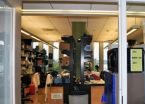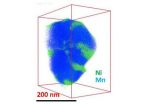(Press-News.org) A new regulator for heart formation has been discovered by studying how embryonic stem cells adjust the packaging of their DNA. This approach to finding genetic regulators, the scientists say, may have the power to provide insight into the development of any tissue in the body – liver, brain, blood and so on.
A stem cell has the potential to become any type of cell. Once the choice is made, the cell and other stem cells committed to the same fate divide to form organ tissue.
A University of Washington-led research team was particularly interested in how stem cells turn into heart muscle cells to further research on repairing damaged hearts through tissue regeneration. The leaders of the project were Dr. Charles Murry, a cardiac pathologist and stem cell biologist; Dr. Randall Moon, who studies the control of embryonic development, and Dr. John Stamatoyannopoulos, who explores the operating systems of the human genome.
The paper's lead author is Dr. Sharon Paige, a UW MD-PhD student who completed her Ph.D. in Dr. Murry's lab.
The results are published in the Sept. 28 edition of Cell.
Paige, an aspiring pediatric cardiologist, said, "By identifying regulators of cardiac development, this work has the potential to lead to a better understanding of the causes of congenital heart disease, thereby paving the way for therapeutic advances."
Previously UW researchers had examined the signals that prod cells to grow into various kinds of heart tissue. In this case, the researchers entered a relatively unexplored area. They decided to look at the genetic controls behind the transformation of stem cells into heart tissue.
Because stem cells keep their DNA code under wraps until needed, the scientists examined how this packaging is altered over time to permit reading of portions of the code and thereby produce changes in the cell.
DNA is wound up into a structure called chromatin. "DNA can be packaged as tightly closed, neutral or activated," Murry explained. The tightly closed state, he said, is analogous to setting the brakes on a car.
Like a child who clams up when asked, "What will you be when you grow up?" stem cells are protective of the genes that will determine their future cell type, or what scientists call their cell fate.
"We found that stem cells take great care to avoid turning on cell-fate regulating genes at the wrong time," Murry said. "These genes have their brakes on until they are needed." When the time is right, he said, "the brakes come off and the gas goes on."
He explained that the situation is different for genes that regulate cell functions, in contrast to those that regulate cell fate. Genes that control, for example, the production of proteins that allow the cell to contract or to generate electrical signals do not have such a complex braking system. Those genes can be more readily activated.
The researchers pointed out that it was already known that the patterns stem cells follow to modify their DNA packaging distinguished them from progenitor cells – cells prepared to begin a lineage of a particular type of cell – and also from cells that already had a working identity, such as blood or muscle cells.
However , the dynamics of the DNA packaging modifications – how the packaging is programmed to change over time—and how these dynamics influence which genes are "exposed" and activated to create, for example, heart muscle cells, was poorly understood.
The UW-led research team learned that, as human embryonic stem cells become heart cells, this differentiation is accompanied by distinctive dynamic alterations in DNA packaging. This tell-tale pattern enabled the scientists to distinguish the key regulators of heart development from other genes. The researchers referred to the carefully timed pattern of changes in the DNA wrapping as a "temporal chromatin signature."
Just as a bank robber leaves incriminating evidence in a handwritten note to the teller, the temporal chromatin signature gave the scientists the clues they needed to hunt down new genes that might be responsible for heart formation.
"We found a bunch of them," Murry said. Their system revealed the top candidate to be the homebox gene MEIS2. This gene seemed an unlikely choice because it had no previous record of participating in heart formation. However, when this gene was removed from a new generation of zebra fish, the developing fish embryos had heart tube formation defects and other heart abnormalities.
Murry and other members of the research team think patterns in DNA unwrapping could be broadly applicable to discovering the genes that regulate other aspects of tissue and organ formation beyond only the heart. Such a research approach might help reveal the major developmental decisions that occur inside of cells as an embryo forms and grows. These revelations could provide information useful to spurring stem cells to form specific tissues for organ repair later in life.
Acknowledging the limitations of a lab system in mimicking what happens inside living cells in the early stages of organ formation in humans, Murry said, "The use of the temporal chromatin signature to discover regulatory genes could give us new insights into human development and new tools to control cell fate."
INFORMATION:
This study was supported by grants from the National Institutes of Health P01 GMO081719, U01 HL100405, P01 HL094374, R01 HL084642, R01 HL64387, R03 AR057477, and the UW ENCODE Center (U54HG004592). Randal Moon is a Howard Hughes Medical Institute Investigator.
Dynamics of DNA packaging helps regulate formation of heart
Findings hold promise for heart regeneration and understanding congenital heart defects
2012-09-28
ELSE PRESS RELEASES FROM THIS DATE:
Enhancing oral health via sense of coherence: A cluster randomized trial
2012-09-28
Alexandria, Va., USA – Today, the International and American Associations for Dental Research (IADR/AADR) published a study titled "Enhancing Oral Health via Sense of Coherence: a Cluster Randomized Trial." This study by lead author Orawan Nammontri, University of Sheffield, UK, is published in the IADR/AADR Journal of Dental Research.
Sense of coherence (SOC) has been related to oral health behaviors and oral health related quality of life (OHRQoL) in observational studies. This cluster randomized trial aimed to test the effect of an intervention to enhance SOC on OHRQoL ...
Napiergrass: A potential biofuel crop for the sunny Southeast
2012-09-28
This press release is available in Spanish.A grass fed to cattle throughout much of the tropics may become a biofuel crop that helps the nation meet its future energy needs, according to a U.S. Department of Agriculture (USDA) scientist.
Napiergrass (Pennisetum purpureum) is fairly drought-tolerant, grows well on marginal lands, and filters nutrients out of runoff in riparian areas, according to William Anderson, a geneticist in the Agricultural Research Service (ARS) Crop Genetics and Breeding Research Unit in Tifton, Ga. ARS is USDA's principal intramural scientific ...
New clues about ancient water cycles shed light on US deserts, says Texas A&M-led study
2012-09-28
The deserts of Utah and Nevada have not always been dry. Between 14,000 and 20,000 years ago, when large ice caps covered Canada during the last glacial cooling, valleys throughout the desert southwest filled with water to become large lakes, scientists have long surmised. At their maximum size, the desert lakes covered about a quarter of both Nevada and Utah. Now a team led by a Texas A&M University researcher has found a new water cycle connection between the U.S. southwest and the tropics, and understanding the processes that have brought precipitation to the western ...
Peering to the edge of a black hole
2012-09-28
Using a continent-spanning telescope, an international team of astronomers has peered to the edge of a black hole at the center of a distant galaxy. For the first time, they have measured the black hole's "point of no return" - the closest distance that matter can approach before being irretrievably pulled into the black hole.
A black hole is a region in space where the pull of gravity is so strong that nothing, not even light, can escape. Its boundary is known as the event horizon.
"Once objects fall through the event horizon, they're lost forever," says lead author ...
New fish species offers literal take on 'hooking up'
2012-09-28
Fishing hooks aren't the only hooks found in east-central Mexican waters.
A new species of freshwater fish described by a North Carolina State University researcher has several interesting – and perhaps cringe-inducing – characteristics, including a series of four hooks on the male genitalia.
Females of the new species – the llanos mosquitofish, or Gambusia quadruncus – also have distinguishing characteristics, including a colorful anal spot.
A paper describing the new species, which lives in a diversity hotspot and seemingly branched off from its closest relative ...
Deadly complication of stem cell transplants reduced in mice
2012-09-28
Studying leukemia in mice, researchers at Washington University School of Medicine in St. Louis have reduced a life-threatening complication of stem cell transplants, the only curative treatment when leukemia returns.
About 50 percent of leukemia patients who receive stem cells from another person develop graft-versus-host disease, a condition where donor immune cells attack the patient's own body. The main organs affected are the skin, liver and gut. Now, the scientists have shown they can redirect donor immune cells away from these vital organs. Steering immune cells ...
Nickelblock: An element's love-hate relationship with battery electrodes
2012-09-28
RICHLAND, Wash. -- Anyone who owns an electronic device knows that lithium ion batteries could work better and last longer. Now, scientists examining battery materials on the nano-scale reveal how nickel forms a physical barrier that impedes the shuttling of lithium ions in the electrode, reducing how fast the materials charge and discharge. Published last week in Nano Letters, the research also suggests a way to improve the materials.
The researchers, led by the Department of Energy's Pacific Northwest National Laboratory's Chongmin Wang, created high-resolution 3D ...
Measuring the universe's 'exit door'
2012-09-28
CAMBRIDGE, MA -- The point of no return: In astronomy, it's known as a black hole — a region in space where the pull of gravity is so strong that nothing, not even light, can escape. Black holes that can be billions of times more massive than our sun may reside at the heart of most galaxies. Such supermassive black holes are so powerful that activity at their boundaries can ripple throughout their host galaxies.
Now, an international team, led by researchers at MIT's Haystack Observatory, has for the first time measured the radius of a black hole at the center of a distant ...
World's first glimpse of a black hole 'launchpad'
2012-09-28
A strange thing about black holes: they shine.
The current issue of Science Express features a paper by the Event Horizon telescope team – a collaboration that includes Avery Broderick, Associate Faculty at Perimeter Institute – that may shed light on the origin of the bright jets given off by some black holes. In a world first, the team has been able to look at a distant black hole and find out where its jets are launched from: the "launchpad".
Many galaxies, including our own Milky Way, have a huge black hole lurking at their cores. In about 10 percent of such galaxies, ...
Newspaper sales suffer due to lack of stimulating content
2012-09-28
Los Angeles, CA (September 27, 2012) – Since the newspaper industry started to experience a major decrease in readership in recent years, many people have deemed the internet and other forms of new media as the culprits. However, a recent study published in the Journalism & Mass Communication Quarterly, a SAGE Journal, finds that sales are down because readers need more engaging and stimulating content.
Study authors Rachel Davis Mersey, Edward C. Malthouse, and Bobby J. Calder suggested that it is crucial for journalists and practitioners to focus their efforts on creating ...
LAST 30 PRESS RELEASES:
New modeling approach sheds light on rare gut disease
Study documents potentially hazardous flame retardants in firefighter gear
Can certain bacteria regulate aging of the immune system and its related alterations?
AI model helps diagnose often undetected heart disease from simple EKG
There are fewer online trolls than people think
Cell membrane fluctuations produce electricity
Jeonbuk National University study shows positive parenting can protect adolescents against self-harm
Surface-engineered ZnO nanocrystals to tackle perfluoroalkyl substance contamination
This new understanding of T cell receptors may improve cancer immunotherapies
A new fossil face sheds light on early migrations of ancient human ancestor
A new immunotherapy approach could work for many types of cancer
A new way to diagnose deadly lung infections and save lives
40 percent of MRI signals do not correspond to actual brain activity
How brain-inspired algorithms could drive down AI energy costs
Gum disease may be linked to plaque buildup in arteries, higher risk of major CVD events
Contrails are a major driver of aviation’s climate impact
Structure of dopamine-releasing neurons relates to the type of circuits they form for smell-processing
Reducing social isolation protects the brain in later life
Keeping the heart healthy increases longevity even after cancer
Young adults commonly mix cannabis with nicotine and tobacco
Comprehensive review illuminates tau protein's dual nature in brain health, disease, and emerging psychiatric connections
Book prepares K-12 leaders for the next public health crisis
Storms in the Southern Ocean mitigates global warming
Seals on the move: Research reveals key data for offshore development and international ecology
Sports injuries sustained during your period might be more severe
World's first successful 2 Tbit/s free-space optical communication using small optical terminals mountable on satellites and HAPS
Can intimate relationships affect your heart? New study says ‘yes’
Scalable and healable gradient textiles for multi‑scenario radiative cooling via bicomponent blow spinning
Research shows informed traders never let a good climate crisis go to waste
Intelligent XGBoost framework enhances asphalt pavement skid resistance assessment
[Press-News.org] Dynamics of DNA packaging helps regulate formation of heartFindings hold promise for heart regeneration and understanding congenital heart defects



